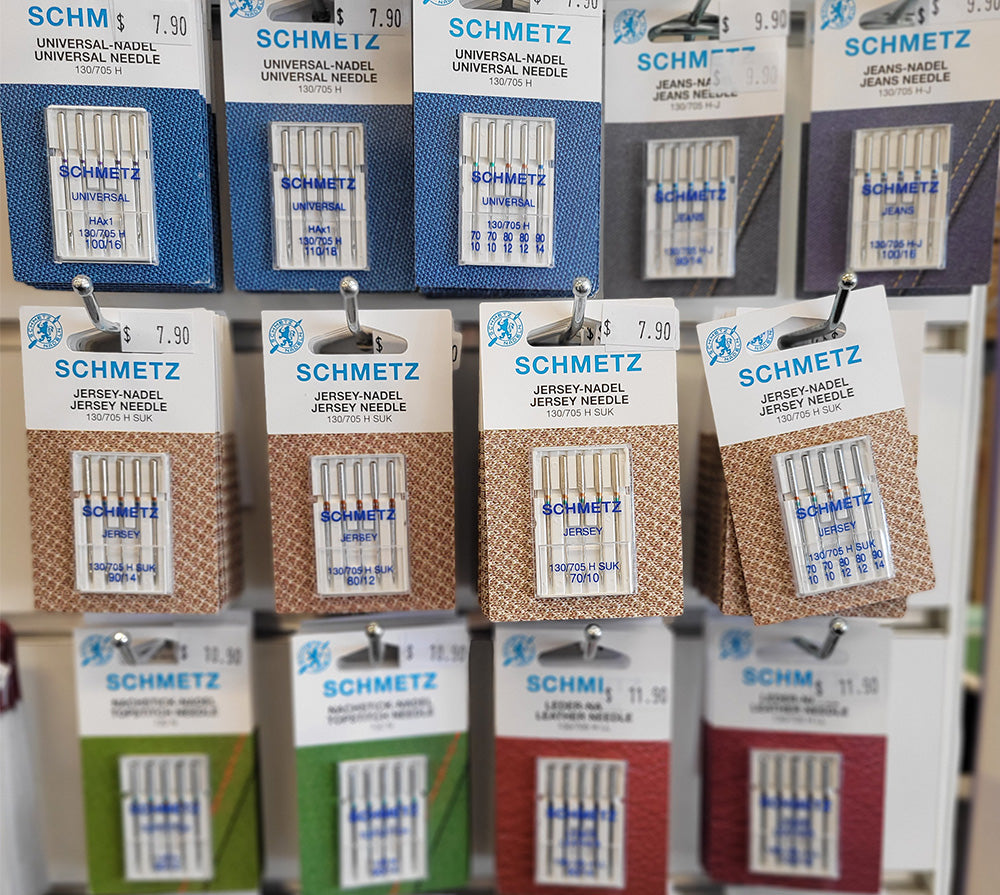CHOOSING A NEEDLE TO SUIT YOUR MACHINE
Choosing a needle to suit your machine and or fabric can become quite confusing for some of us.
Using the incorrect needle is one of the most common mistakes, it can lead to needle breakage, difficulty working with different fabrics and poor stitch quality.
The number of different size and types of needles can be bewildering at first, however by the time you have finished reading this, I'm sure you will be more confident in choosing the correct needle for your project.
When you see 130/705H this means that the needle is for use on a home sewing machine, the needle will have a flat shank and scarf
NEEDLE SIZES
10/70: Very fine fabric
Silk, chiffon, organza, voile, fine lace and fine merino knit
11/75:Light weight fabric
Cotton voile, silk, synthetics, spandex and lycra
12/80:Light weight fabric
Cotton voile, shirt weight fabric, silk, synthetics, spandex and lycra
14/90: Medium weight fabric
Quilting fabrics, cotton, velvet, fine , linen, muslin, jersey, knits, light wool, sweatshirt knit and fleece
16/100 :Heavy weight fabric
Denim, heavy canvas, duck cotton, suiting, leather
NEEDLE TYPES
UNIVERSAL NEEDLES
Universal needles are the most commonly used needle, they will even sew some knit fabrics, as well as the ever popular woven fabrics. The finer needles are used for lightweight fabrics and the larger needles used on medium to heavier fabrics.
Our Gutermann sew all polyester thread should be used with a universal needle, however you can also use a cotton or silk thread as long as it is of high quality.
BALL POINT NEEDLES
These needles have a rounded tip which makes them ideal for working with interlock, fleece and generally most knit fabrics because when the needle goes through the fabric it pushes the fibres apart rather than cutting them, in turn prevents laddering.
STRETCH NEEDLES
A stretch needle has a scarf which allows extra room for the the hook to pass close by and prevents skipped stitches. This is ideal when sewing very stretch fabric such as Lycra, silk jersey, spandex and fabrics with a high elastic content. These fabrics are generally known to be difficult to work with and with the correct needle you are achieving a great result.
QUILTING NEEDLES
Quilting needles are designed to be used with several layers of fabric and wadding as they have a reinforced shaft.
JEANS NEEDLES
Denim is the choice for these needles, however they are ideal to be used on most dense fabrics such as heavy twill, canvas, heavy linen and heavy work clothes. The needle has a very strong shank and sharp point t push through the fabric preventing bending or breakage. With these needles you can use a heavier thread as the eye is larger for threading as well.
LEATHER NEEDLES
Leather needles have a chisel point, which acts like a chisel when using. They are to be used with genuine leather, suede and difficult to sew fabrics. They should not be used with imitation leather or suede because of the characteristics of the both kind of materials.
EMBROIDERY NEEDLES
These needles are designed with a larger eye to allow the threads to pass through with out shredding. Missed stitches can be a problem when using a normal needle, this is because of the rapid movement of the needle, the embroidery needle has a pontoon scarf with an oversized bump which reduces this happening by reducing the amount of friction of the thread on the needle.
TOP STITCH NEEDLES
Top stitch needles have an extra sharp point which pierces all types of fabrics easily and it has a larger eye where thicker threads can be used.
TWIN NEEDLES
Twin needles are used for replicating a double top stitch like a coverstitch machine will make on a hem. They are also used for decorative stitching aor making pintucks. All machines are not compatible with twin needling so check your manual first.
WHEN TO CHANGE YOUR NEEDLE.
It is recommended that you change your needle after every project or after 7-8 hours of sewing. If you are hearing unusual noises whilst running your machine it is generally a good idea to change the needle before calling a service agent as quite often that will be the problem, the needle may be slightly bent or has a burr on the point which could be causing this. Dull needles will cause the machine to make a thudding sound when sewing as the motor needs to work harder to force the needle through the fabric.

